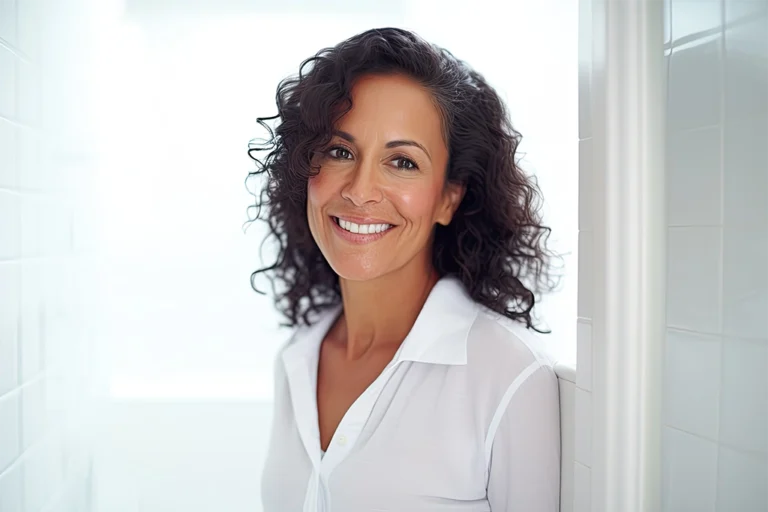Doctors recommend women get a mammogram as an annual breast cancer screening starting at age 40. The American Society of Breast Surgeons recommends a 3D mammogram (digital breast tomosynthesis) as your annual scan. A 3D mammogram offers several benefits that are missing from a regular mammogram but has a few drawbacks as well. Keep reading to find out if you should replace your annual mammogram with a 3D one.
The main difference between a 3D mammogram and a regular mammogram is that a 3D mammogram gives your doctor both a 2D image and a 3D digital recreation of your breasts. This 3D recreation offers more detailed information about irregularities. That is what makes the 3D mammogram the preferred option for women with dense breast tissue. On a regular mammogram, cancer shows up as a white area, while fatty tissue is dark. Dense breast tissue sometimes shows up as white areas, making it difficult for a doctor to know if it could be a tumor or mass. By using a 3D mammogram, your doctor will be able to assess the difference between tissue and tumor to a higher degree than with a regular mammogram.
What Is Dense Breast Tissue?
It is nearly impossible to tell if you have dense breast tissue without a mammogram — 3D or otherwise. Dense breast tissue is simply a concentration of tissue — it causes no harm. It is a genetic trait, although a low body mass index or menopausal hormone therapy can increase the likelihood of developing dense breast tissue. As you age or have children, your breast tissue becomes less dense.
About half the women screened for breast cancer have dense breast tissue. Women with dense breast tissue are usually at a higher risk for breast cancer, which only makes it more vital that they receive the best possible scan. If you have dense breast tissue, you should not get more than an annual mammogram, although you should maybe consider switching from a regular mammogram to a 3D mammogram.
In the recent past, 3D mammograms were less common and were usually only used when a regular mammogram showed an irregularity and doctors wanted more information. If a doctor wanted an even more detailed look at an irregularity, they might use an MRI or an ultrasound. Both an MRI and ultrasound are more expensive and involved than a 3D mammogram but allow your doctor to better understand the irregularities your 3D mammogram might’ve revealed. By replacing your annual mammogram with an annual 3D mammogram, you might avoid this additional imaging (and the additional cost!).
The biggest drawback to 3D mammograms is overdiagnosis. A 3D mammogram is excellent for spotting cancers, but it can diagnose abnormalities that turn out to be harmless, which can increase unnecessary imaging and procedures. It’s hard to believe, but there are actually some abnormalities that are better left alone rather than treated with a potentially expensive and invasive procedure.
3D mammograms, like all imaging tests, can be wrong sometimes. More often than not, though, 3D mammograms reveal irregularities or masses that a 2D mammogram would not have picked up on. Sometimes, this new information can cause lots of stress and fear, when the reality is some of those irregularities that are treated with costly scans and procedures weren’t life-threatening at all. Other times, it can be lifesaving.
How Do I Prepare For A 3D Mammogram?
Whether or not you decide a 3D mammogram is right for you, preparing for a mammogram is simple. Preparing for a 3D mammogram is the same process as a regular mammogram. Do your best to not wear deodorant, lotions, or any cosmetic products that could contain microscopic bits of metal. Try to schedule your mammogram during a week when your breasts will be the least tender (likely the week after your menstrual period). Bring any copies of other mammogram scans with you to your appointment. Wear comfortable, loose-fitting clothing. You will have to take your shirt off to perform the scan, and you don’t want to have any metal in your clothing that could potentially interfere with the X-ray technology.
The entire process of your mammogram should take around 10 minutes. A 3D mammogram is the same procedure as a regular mammogram. During a mammogram, a plastic plate will press down on your breast to keep it in place and spread out the tissue. The process is repeated on the other breast. Many women describe this compression as uncomfortable or painful. It might be helpful to take a mild painkiller ahead of your appointment. A regular mammogram involves a minuscule amount of radiation and a 3D mammogram uses slightly more radiation than a regular mammogram.
Getting called back after a 3D mammogram is not a cause for panic. There might be something small that your doctor wants to look at. It’s perfectly normal to get called back for more imaging since your doctor wants to be better safe than sorry when it comes to your health. Your 3D mammogram results will be sent to your doctor anywhere from within a week to within a month. Your doctor will then call you to schedule a follow-up appointment.
Why Do I Need A Follow-Up Appointment After My Mammogram?
Annually, about 10% of women who receive abnormal mammogram results, only 8/10 are biopsied and 80% of those biopsies are benign. If your mammogram shows something irregular, you will get a call from your doctor within a week or two. Sometimes that’s not enough for your doctor to diagnose you with anything so they will have to take some more images and do some more tests to check the irregularity. This happens regardless of what type of mammogram you receive.
A 3D mammogram is slightly more expensive than a regular mammogram. Not all insurance companies cover the cost of a 3D mammogram, though. Usually, insurance companies cover the cost of an annual mammogram. If this is the case for you but you want a 3D mammogram, your insurance will likely cover up to the cost of a regular mammogram and you will have to pay the difference (usually around $60). Although 3D mammograms are slightly more expensive, they might save you from having additional testing later on and offer more clarity than a regular mammogram.
3D mammograms are not yet routine. Some doctors only recommend 2D mammograms, while others prefer 3D mammograms. We offer both. A 3D mammogram is not necessary. You and your doctor could decide if the test is or isn’t right for you – all that matters is that you are getting the care you need, whether that’s a traditional mammogram, a breast ultrasound, or a 3D mammogram.
Any scan is better than no scan: schedule your annual mammogram with SJRA today. Any of our locations where 2D mammograms are also able to do 3D mammograms. With flexible scheduling, expert staff, and designed with your comfort in mind, SJRA is the perfect location for your next screening. Schedule your appointment today at any of the following locations:
- Cherry Hill Office – Cherry Hill, NJ
- Haddonfield Office – Haddonfield, NJ
- Marlton (Greentree) Office – Marlton, NJ
- Moorestown Office – Moorestown, NJ
- Turnersville Office – Turnersville, NJ
- West Deptford Office – West Deptford, NJ
- Willingboro Office – Willingboro, NJ
- Women’s Center at Cross Keys – Sewell, NJ
- Women’s Center at Medford – Medford, NJ
- Women’s Center at Mount Laurel – Mount Laurel, NJ
- Women’s Center at Voorhees – Voorhees Township, NJ
Meet our board-certified, subspecialized radiologists who read and interpret our studies, here.
Frequently Asked Questions
The main difference between a 3D mammogram and a traditional mammogram is that a 3D mammogram provides your doctor with both a 2D image and a 3D digital recreation of your breasts. The 3D mammogram offers more detailed information about irregularities, making it the preferred option for women with dense breast tissue.
Women with dense breast tissue are usually at a higher risk for breast cancer. Dense breast tissue can make it difficult for radiologists to distinguish between normal tissue and potential tumors or masses on a regular mammogram. A 3D mammogram allows radiologists to better assess the difference between tissue and tumor in women with dense breasts.
Dense breast tissue is a concentration of tissue in the breasts that is a genetic trait and causes no harm. It can only be determined through a mammogram. Factors such as a low body mass index or menopausal hormone therapy can increase the likelihood of having dense breast tissue. As women age or have children, their breast tissue tends to become less dense.
Preparing for a 3D mammogram is similar to preparing for a regular mammogram. Avoid wearing deodorant, lotions, or cosmetic products that may contain metal. Schedule the mammogram for a week when your breasts are least tender, typically the week after your menstrual period. Bring any previous mammogram scans with you to your appointment, and wear comfortable, loose-fitting clothing without metal.
The entire process of a 3D mammogram typically takes around 10 minutes, similar to a regular mammogram.
Yes, it is normal to be called back after a 3D mammogram. If there is something that requires further examination or clarification, your doctor may request additional imaging or tests to ensure your health and provide accurate results.
A follow-up appointment after a mammogram allows your doctor to review the results, address any abnormalities or irregularities, and determine the need for further testing or treatment. It is standard practice to ensure comprehensive care and provide accurate diagnoses.
The coverage of 3D mammograms by insurance varies. While most insurance companies cover the cost of an annual screening 2D mammogram, not all may cover the cost difference of an annual screening 3D mammogram. It is recommended to check with your insurance provider regarding coverage details and potential out-of-pocket expenses.
The decision to have a 3D mammogram or choose other screening options should be discussed with your doctor. Various factors, such as your medical history, breast density, and personal preferences, can influence the choice of the screening method. It’s important to work together with your healthcare provider to determine the most suitable option for you.
To schedule a 3D mammogram appointment, reach out to any of our following offices:
• Cherry Hill Office – Cherry Hill, NJ
• Haddonfield Office – Haddonfield, NJ
• Marlton (Greentree) Office – Marlton, NJ
• Moorestown Office – Moorestown, NJ
• Turnersville Office – Turnersville, NJ
• West Deptford Office – West Deptford, NJ
• Willingboro Office – Willingboro, NJ
• Women’s Center at Cross Keys – Sewell, NJ
• Women’s Center at Medford – Medford, NJ
• Women’s Center at Mount Laurel – Mount Laurel, NJ
• Women’s Center at Voorhees – Voorhees Township, NJ
You can find information about our board-certified, subspecialized radiologists by viewing our physician profiles.



